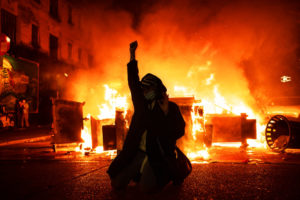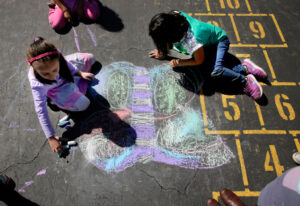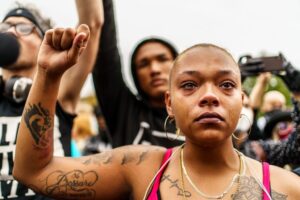I was feeling an oddly serene mix of relief and pleasure and fatherly accomplishment, sitting in a barbershop on a sunny Saturday afternoon, watching my 12-year-old son get his hair cut roughly a month too late. As hanks of blond hair dropped onto the floor tiles, the contours of his handsome head began to show. I was feeling good about this needful errand, this little adventure. I wasn’t cutting his hair myself, of course, but hadn’t I brought him here? Hadn’t I made this haircut happen, at long last? I deserved enough credit, I figured, to relish my sleepy gazing through the big barbershop window, as if this gazing was another thing that, needing to be done, was finally getting done.
The haircut was about half-finished when I heard several sounds of a brief, intense disturbance happening on the street just out of view — a car turning sharply and then braking hard, a muffled smash, a car turning and accelerating again, and then the long blast of a horn. Having all this audible drama happen just outside my perspective, when that perspective captured so much, was acutely frustrating. I felt like the victim of a cinema technique. Someone was cagily withholding information from me! But when I roused myself and went outside, six or seven people were already standing on the sidewalk in front of the restaurant next door. From them, none of the information I was hungering for had been withheld. A few of these people were moving behind a Honda SUV that was parked at the curb so they could get a better look at the hole that had just been smashed in its back window. A laptop had just been stolen, right in front of them, as if for their bourgeois scrutiny and disapproval.
This was pretty brazen, but it’s not nearly the most brazen recent street theft in and around my Oakland, California neighbourhood. Several times over the past couple of months, I or my children have been walking along the crowded sunlit sidewalk of the busy commercial street near where we live as a late-model car raced up and loudly braked mere feet away, and a young man in a hoodie and Covid mask leapt out, smashed a car window, grabbed something from inside, and leapt back into the getaway car. Or, it wasn’t exactly a getaway car, or at least not right away, because these teams tend to repeat the procedure further up a street before U-turning violently to shop the cars on the opposite side, the whole time holding the stunned attention of Oakland pedestrians, who are well accustomed to car burglary but conditioned from earlier years to think of it as something done in stealth, generally when they’re asleep.
I seethe when I see this brazen shit. But why I (and my fellow citizens with similar anger issues) don’t intervene is shown by another act of brazenness that happened three doors down from my house last month. Several carpenters were on their lunchbreak, standing or sitting near their two trucks when a car pulled up and a young man jumped from the passenger’s seat and into the driver’s seat of one of the trucks. Two of the workers were around the truck and upon this guy a little faster than he was expecting, but no matter. As they yanked the would-be thief to the ground, the crime car’s driver yelled to them through the passenger window. They looked up to see him making the universal gesture for: “I will shoot you if you do not release my esteemed colleague from your rough grip, post haste.”
Of course they had a gun. This, despite how angry I get, is why I don’t intervene. Sometimes my anger is so intense it feels suicidal, the honour-code anger of someone ready to die to make a point, but then it thinks of the guy driving the car, and it pictures the gun this guy is almost certainly holding, and it chooses life. On my behalf, my anger stands down.
I linger over my own reactions to this crime experience not to make a spectacle of myself, to boast of my proud moments of impotent rage, but to note a curious aspect of the crime wave American cities are presently suffering. In my town, many crimes such as car break-ins and carjackings have spiked dramatically this year (though homicides, thankfully, have declined slightly from their alarming post-Covid peaks). But what seems really new is how and when — and by implication why — these crimes are committed. A striking number of them are done in daytime, in public, in front of an audience of shoppers and workers and pedestrians forced to look on uselessly, lest a spirit of civic outrage overtake them, and get them shot.
Street crime has become oddly social, in other words. Acts of violence and theft have assumed a gestural aspect. They seem performative, self-aware, almost conversational. Even if the young men conducting the busy procedures of breaking into one vehicle after another appear lost in concentration, immersed in their careful labours, one must imagine they’re also aware of the stunned and appalled people all around them. Whenever you’re doing something that’s causing people to stare at you, no matter how involving or rewarding it is, it’s hard to keep their attention from informing your broader experience, and to ignore how your actions are informing theirs. When I played basketball in high school, for example, the intensities of the game itself commanded most of my awareness, but I still had a fair amount left over for the hundreds of people watching me run around in little shorts.
For the figures most sympathetic to them in city government, though, our prolific criminals are becoming an inconvenience. By breaking into and stealing so many cars, burgling and invading so many houses, and carjacking so many unsuspecting drivers, these energetic thieves and assailants have created a population of fresh victims large enough to be electorally meaningful in its own right in a city with fewer than 500,000 people. As of late September, for example, more than 11,000 cars had been reported stolen in Oakland — which was already 2,000 more than the total for all of last year. According to police statistics, this year has seen more reported car thefts than car break-ins — but that is because, as one report has it, “people don’t report break-ins anymore”, since the understaffed and overwhelmed police don’t do anything when you do. (Not only do they not visit you in person, to offer a sympathetic ear at the puddle of pebbled glass next to your car. In my experience they don’t even email to acknowledge you’ve submitted your online crime report.) And now as a result of this crime surge, public meetings around the city are filling up with angry crime victims who yell unsupportive things at Oakland Mayor Sheng Thao, an incompetent young progressive who, in safer times, built her political brand on hostility to law enforcement.
More damaging to her political fortunes and those of her progressive allies, though, and perhaps more corrosive of their larger cause, is the public assault, by all this public lawbreaking, on their theory of what crime is and why it happens in the first place. For our Mayor, like progressive activists around the country, the causes of crime most important to talk about are “structural” — poverty, inequality, the “generational trauma” of racism, just plain racism, and so on. She likes to redirect discussions of crime so as to distance herself from the unpleasant matter of policing, reliably changing the subject to the “root causes” of crime. One news article captured her view in a paraphrase: “Thao said in her mind, no one would choose a life of crime, so getting to the root causes is important.” Since no one would choose a life of crime, her thinking seems to go, the individual criminal acts that make up such a life or start one on its path must not be chosen either.
The main point here is that the agency of lawbreakers is somehow constrained or compromised, if we can really say it exists at all. As an Oakland resident, I’ve been the victim of several overnight auto break-ins, and even I have made a sociologist’s effort of sympathy towards the anonymous people who smashed my car windows — if mainly to medicate my toxic anger at being a crime victim once again. We’d wake up to a smashed car window and my wife would tell me that, for my own sake, I should try feeling compassion for the person who did it, rather than anger or offence. And as usual, she was right. It was simply healthier, mentally and physically, to view these window smashers as something like points of convergence, sites on the social body where unhealthy forces intersect to yield an unwell or desperate impulse, from which issues a regrettable act.
Such thinking is likewise therapeutic for our Mayor and other urban progressives who’ve won elections. It is an unhappy fact of governing that they find themselves in charge of, and thus unfashionably associated with, police departments. It soothes them in this predicament, when someone’s arrest and confinement are obviously justified and unavoidable, to breathe out a miasma of jargon about structural oppression and root causes as if they’re critiquing the law for making them enforce it. And it justifies their inaction in other cases, when some extenuation can be conjured that spares the offenders any punishment, to speak as if these offenders suffer from an absence of conscious will or human agency.
But it’s easier to think of lawbreakers as lacking consciousness and agency, as mere objects of abstract structural forces, when crime itself is an abstraction, conducted out of sight, overnight, as if a dreamlike result of one’s own sleeping. When a window smasher is doing his thing in broad daylight, on the other hand, when you’re watching him beside a car and his focused eyes flit from his work to his audience, so that as an onlooker you might find yourself sharing a glance with him, he appears to have not just agency but a bubbling surplus of it. He looks like the most purposeful, composed, indeed self-realised person on the street, and by a good distance.
Think of the choreography that combines precision driving in close traffic with a young man’s timely dancing from the passenger seat of an attractive car, his focus and composure over repeated acts of window-smashing and extracting other people’s possessions. This belies any sense that you’re watching acts of impulse, performed by people who lack agency thanks to oppressive structures. The unwelcome suspicion you get is that, no, these are human beings in full possession of their faculties. They don’t lack judgement or impulse control. They’re using sound judgement at several levels — the basic practical judgement of which streets to choose, and which cars, and when to stop, when to hop out, how long to spend on each theft, and then the higher-level judgement that says this auto burglary thing is a safe proposition because those frightened pedestrians won’t do anything — and the police are too busy to bother us.
This sense of full agency and conscious, vigorous industry also comes through in surveillance videos of recent local crimes — videos of a robbery team carefully using a car to break into several auto repair shops on the same block; a young man calmly pistol-whipping a woman across the face as he begins to rob her; another young man who, showing real commitment to his task, drags a screaming woman down a street by the strap of her purse.
This impression — of able young men calmly, consciously at a task they understand the meaning of — is deepened further by the social aspect of these crimes. It is virtually impossible to imagine they’re not aware of their audience, that they don’t feel themselves operating within the network of moral perceptions they have brought to life with their actions. How many other people similarly tempted to violate their fellow citizens have access to so much social feedback?
But wait a minute. Why are they on a busy commercial street in the first place? The nearby residential streets are also packed with parked cars, but quiet. The thieves could do their Bluetooth scanning along those streets, discovering the odd car with a laptop slipped into its trunk, and they could do this without all those pedestrians watching, all those witnesses. Given this, you’re almost forced to conclude that the pedestrian audience is sort of the point.
This is consistent with economic analyses of street crime I have seen, which suggest the normal payoff of mugging and burgling is quite low relative to the risk, unless you factor into this payoff the pleasure of transgression and dominance, the simple fun of teasing danger and crossing limits to fuck with other people. This makes even more sense when you imagine how far the value of stolen laptops, or those 10,000 stolen cars, has fallen during our current crime wave, with so many of them freed from their previous owners and cluttering the contraband markets. Those things must be worth far less these days, which means the pleasure of stealing them — perhaps especially in front of other people — must be worth a lot.
Disclaimer
Some of the posts we share are controversial and we do not necessarily agree with them in the whole extend. Sometimes we agree with the content or part of it but we do not agree with the narration or language. Nevertheless we find them somehow interesting, valuable and/or informative or we share them, because we strongly believe in freedom of speech, free press and journalism. We strongly encourage you to have a critical approach to all the content, do your own research and analysis to build your own opinion.
We would be glad to have your feedback.
Source: UnHerd Read the original article here: https://unherd.com/




